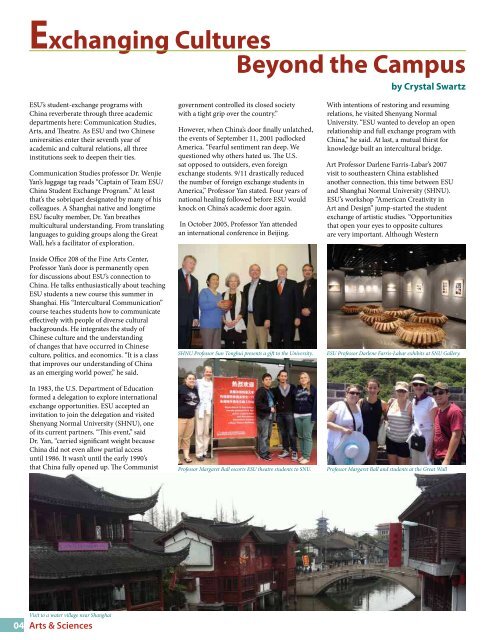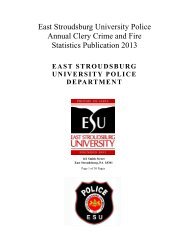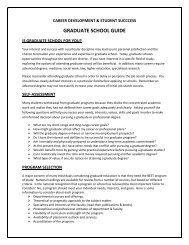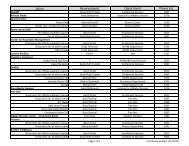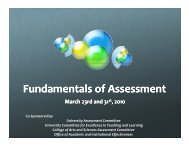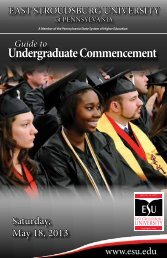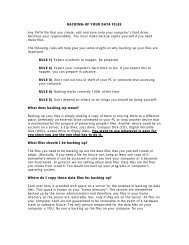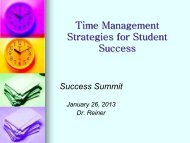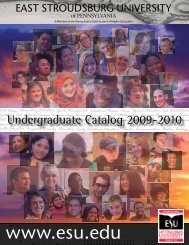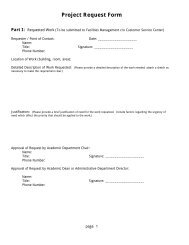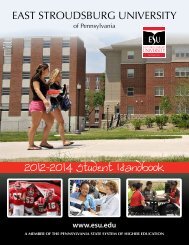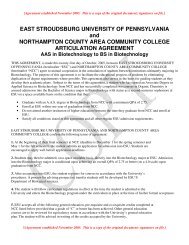2011-2012 report - East Stroudsburg University
2011-2012 report - East Stroudsburg University
2011-2012 report - East Stroudsburg University
You also want an ePaper? Increase the reach of your titles
YUMPU automatically turns print PDFs into web optimized ePapers that Google loves.
Exchanging Cultures<br />
Beyond the Campus<br />
by Crystal Swartz<br />
ESU’s student-exchange programs with<br />
China reverberate through three academic<br />
departments here: Communication Studies,<br />
Arts, and Theatre. As ESU and two Chinese<br />
universities enter their seventh year of<br />
academic and cultural relations, all three<br />
institutions seek to deepen their ties.<br />
Communication Studies professor Dr. Wenjie<br />
Yan’s luggage tag reads “Captain of Team ESU/<br />
China Student Exchange Program.” At least<br />
that’s the sobriquet designated by many of his<br />
colleagues. A Shanghai native and longtime<br />
ESU faculty member, Dr. Yan breathes<br />
multicultural understanding. From translating<br />
languages to guiding groups along the Great<br />
Wall, he’s a facilitator of exploration.<br />
Inside Office 208 of the Fine Arts Center,<br />
Professor Yan’s door is permanently open<br />
for discussions about ESU’s connection to<br />
China. He talks enthusiastically about teaching<br />
ESU students a new course this summer in<br />
Shanghai. His “Intercultural Communication”<br />
course teaches students how to communicate<br />
effectively with people of diverse cultural<br />
backgrounds. He integrates the study of<br />
Chinese culture and the understanding<br />
of changes that have occurred in Chinese<br />
culture, politics, and economics. “It is a class<br />
that improves our understanding of China<br />
as an emerging world power,” he said.<br />
In 1983, the U.S. Department of Education<br />
formed a delegation to explore international<br />
exchange opportunities. ESU accepted an<br />
invitation to join the delegation and visited<br />
Shenyang Normal <strong>University</strong> (SHNU), one<br />
of its current partners. “This event,” said<br />
Dr. Yan, “carried significant weight because<br />
China did not even allow partial access<br />
until 1986. It wasn’t until the early 1990’s<br />
that China fully opened up. The Communist<br />
Visit to a water village near Shanghai<br />
government controlled its closed society<br />
with a tight grip over the country.”<br />
However, when China’s door finally unlatched,<br />
the events of September 11, 2001 padlocked<br />
America. “Fearful sentiment ran deep. We<br />
questioned why others hated us. The U.S.<br />
sat opposed to outsiders, even foreign<br />
exchange students. 9/11 drastically reduced<br />
the number of foreign exchange students in<br />
America,” Professor Yan stated. Four years of<br />
national healing followed before ESU would<br />
knock on China’s academic door again.<br />
In October 2005, Professor Yan attended<br />
an international conference in Beijing.<br />
SHNU Professor Sun Tonghui presents a gift to the <strong>University</strong>.<br />
Professor Margaret Ball escorts ESU theatre students to SNU.<br />
With intentions of restoring and resuming<br />
relations, he visited Shenyang Normal<br />
<strong>University</strong>. “ESU wanted to develop an open<br />
relationship and full exchange program with<br />
China,” he said. At last, a mutual thirst for<br />
knowledge built an intercultural bridge.<br />
Art Professor Darlene Farris-Labar’s 2007<br />
visit to southeastern China established<br />
another connection, this time between ESU<br />
and Shanghai Normal <strong>University</strong> (SHNU).<br />
ESU’s workshop “American Creativity in<br />
Art and Design” jump-started the student<br />
exchange of artistic studies. “Opportunities<br />
that open your eyes to opposite cultures<br />
are very important. Although Western<br />
ESU Professor Darlene Farris-Labar exhibits at SNU Gallery.<br />
Professor Margaret Ball and students at the Great Wall<br />
A view of the Great Wall of China, which ESU faculty and students have the opportunity to visit.<br />
Students and professors from SHNU visit ESU.<br />
A gathering of Chinese students participating in exchanges at ESU during Fall <strong>2011</strong>.<br />
and <strong>East</strong>ern art techniques and creativity<br />
differ, we share an interest in learning the<br />
approaches,” Professor Farris-Labar said.<br />
In January <strong>2012</strong>, SHNU displayed Professor<br />
Farris-Labar’s solo art exhibit, “Worlds<br />
Within Worlds within Worlds,” at Wu Xing<br />
Gallery. A series of watercolors, video art,<br />
and a sculpture installation received notable<br />
admiration. Elements of environmental<br />
sustainability connected her various modes<br />
of expression. SHNU students helped install<br />
sculptures by puffing and folding brown paper<br />
bags into clusters of honeycombs. Prints of<br />
tiny mayflies flew on the gallery walls. An<br />
audience geographically unfamiliar with<br />
these intricate ecosystem contributors still<br />
SHNU students visit Times Square, New York City.<br />
related to the universal theme of nature. After<br />
many visits abroad, the gracious nature of<br />
the people of China continues to impact<br />
Professor Farris-Labar. “You don’t come back<br />
the same. You come back better,” she stated.<br />
The upswing of exchange flowed into<br />
ESU’s Theatre Department in 2010.<br />
At SHNU, Dr. Margaret Ball presented ESU’s<br />
musical theatre program, and Dr. Stephanie<br />
French workshopped ESU’s acting and<br />
directing programs. SHNU hosted their visit<br />
with great generosity. Personalized bright pink<br />
posters greeted them before each event. While<br />
sharing her experiences abroad, Dr. Ball circled<br />
the edges of an ornamental plate with her<br />
hand. “A gift from Shanghai Normal <strong>University</strong>,<br />
its design commemorates an anniversary for<br />
them, but they presented both Dr. French<br />
and me with one during our stay,” she said.<br />
According to Dr. Ball, the spectacle-oriented<br />
nature of musical theatre plays a role in its<br />
current trend within exchange programs.<br />
“People enjoy musicals because they<br />
understand the language of dance and music.<br />
Even with a verbal barrier of words, one can<br />
leave a theatre humming a tune,” she said. An<br />
exchange of fourteen SHNU students visited<br />
ESU for ten days during the fall of <strong>2011</strong>.<br />
SHNU students participated in individual<br />
workshops, improvisational acting exercises,<br />
and joined ESU classes. In addition, the<br />
students took advantage of ESU’s proximity<br />
to New York City. Dr. Ball, with the help of<br />
ESU students and faculty, filled their visit<br />
with field experiences. They attended three<br />
Broadway shows, shopped in Times Square,<br />
and toured the Statue of Liberty, Metropolitan<br />
Museum of Art, and the New York Film<br />
Academy. ESU/China exchange programs take<br />
advantage of the ESU campus’s proximity to<br />
Manhattan. ESU holds the country feel of a<br />
small, connected campus. “Exchange students<br />
won’t feel lost, yet New York City adventures<br />
are only a bus ride away,” said Dr. Ball.<br />
Two years ago, as a sophomore, ESU English<br />
major Laura Dildine studied at SHNU. She<br />
spent a rich month submerged in a different<br />
way of life. Chinese language classes and<br />
tai chi filled her mornings. She relished<br />
the traditional custom of tea ceremonies<br />
and explored geographical sights. Now<br />
a recent graduate, Laura links her selfsufficient<br />
drive to the student exchange<br />
experience. “It’s one thing to know there<br />
are differences out there, but I gained an<br />
authentic understanding, an entirely new<br />
cultural perspective during my studies at<br />
Shenyang Normal <strong>University</strong>,” she said.<br />
<strong>East</strong> <strong>Stroudsburg</strong> <strong>University</strong>, Shenyang<br />
Normal <strong>University</strong>, and Shanghai<br />
Normal <strong>University</strong> have deepened their<br />
partnerships. The benefits of this diverse<br />
exchange embrace both faculty and students.<br />
Footsteps of exploration and understanding<br />
continue to resonate across this bridge.<br />
04 Arts & Sciences College Annual Report <strong>2011</strong>–12 05


